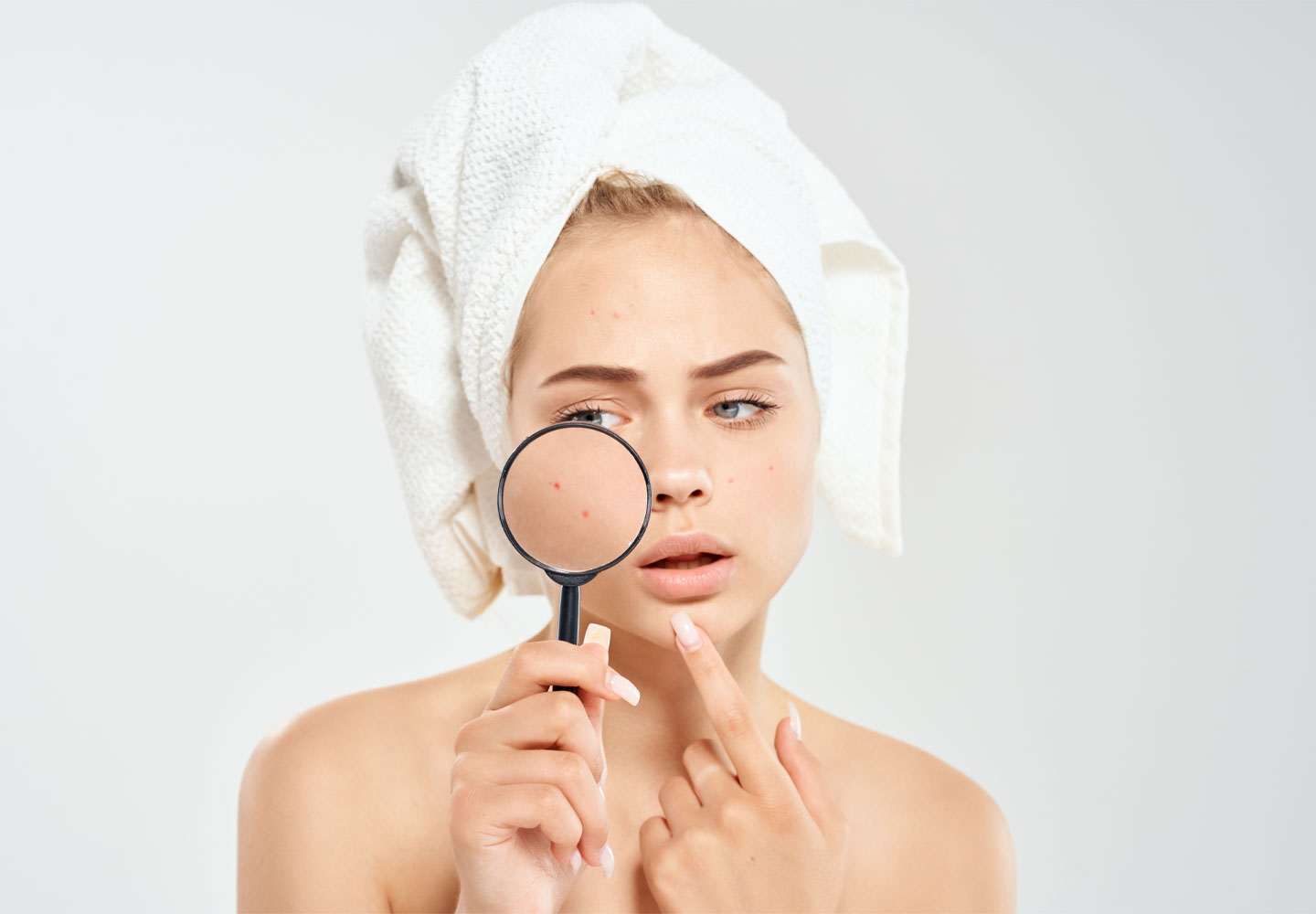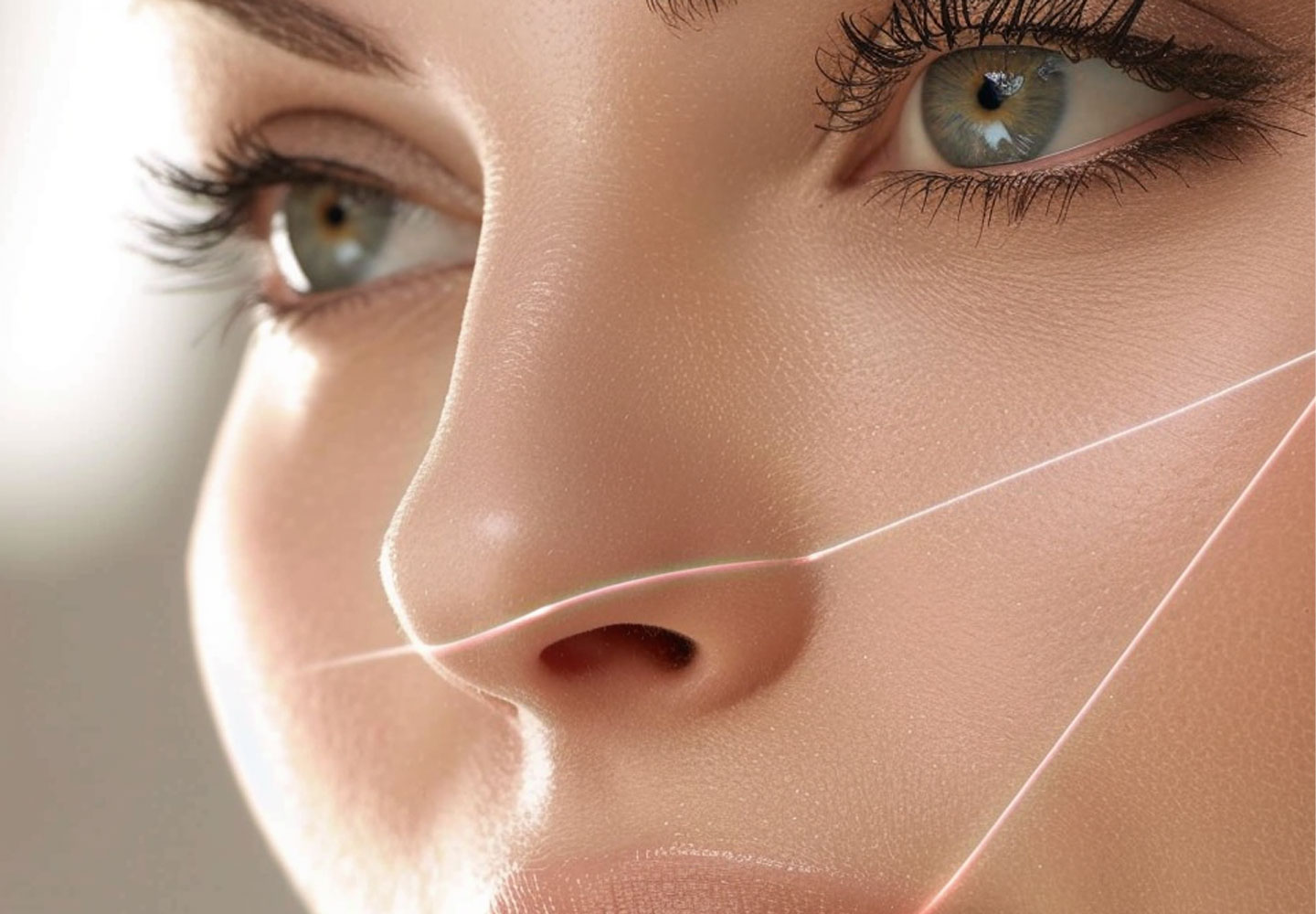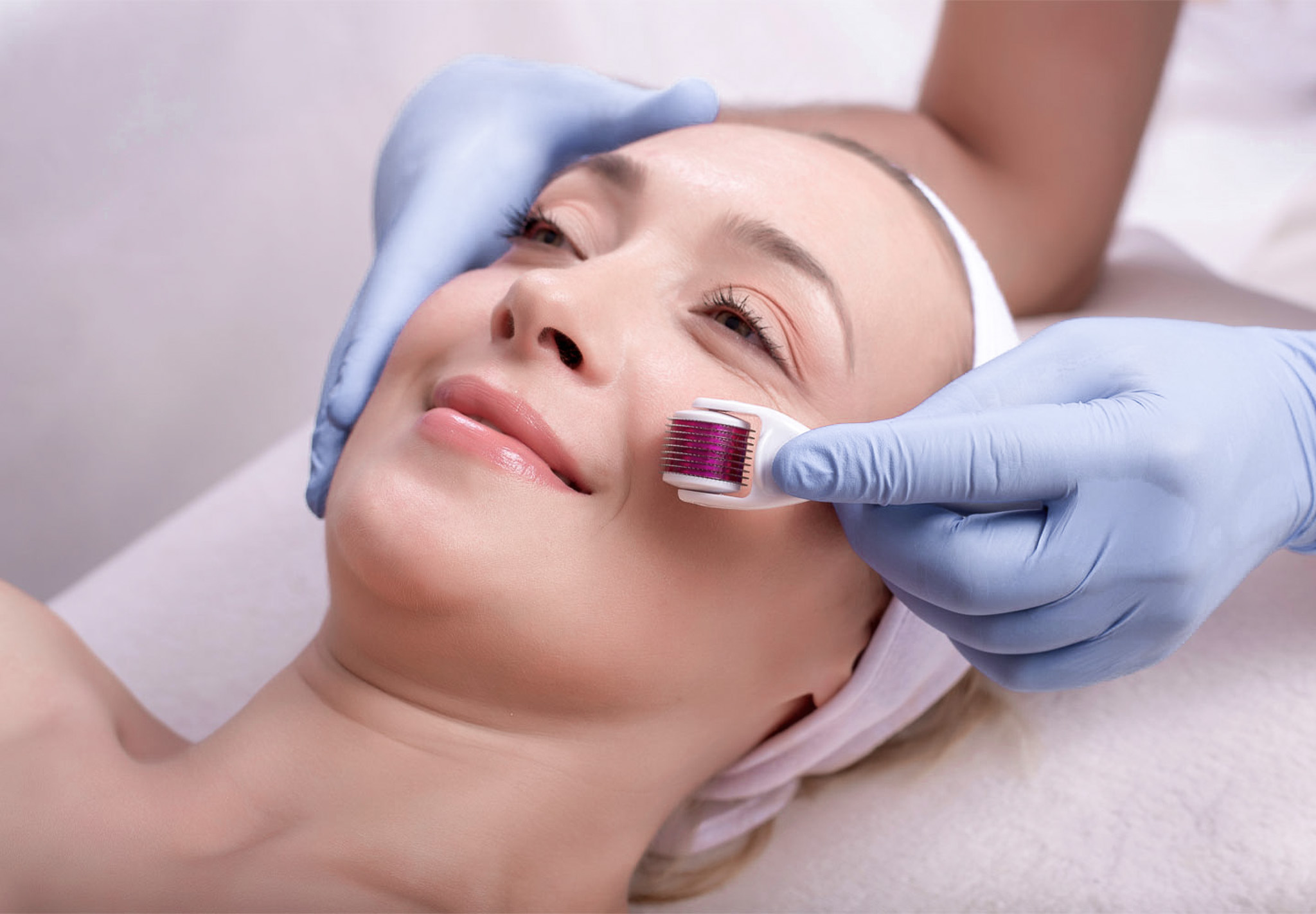Acne scars and their treatments
Acne is an inflammatory skin condition characterised by skin lesions caused by the blockage of the sebaceous glands, the pores.
Find out our prices, scroll down or click here!
Pimple treatment
When acne develops, for unknown reasons, the cells in the inner walls of the pores peel off too quickly and clump together. The dead epithelial cells, mixed with sebum, like a plug, clog the outlet of the sebaceous gland, causing the pore to bulge (this is called a closed or white comedo), when this enlarged hair follicle opens it appears black, this is called an open or black comedo. These are symptoms of non-inflammatory acne. Bacteria normally living on the surface of the skin called Propionibacterium acnes (P. acnes) proliferate in the clogged follicle in an oxygen-free environment. These bacteria produce chemicals and enzymes that create small, inflamed areas of swelling, redness, warmth and pain. After a while, the clogged follicle bursts and discharges everything into the surrounding skin - sebum, dead skin cells and bacteria. Although acne is not a serious threat to health, a severe form can lead to permanent scarring.

Flash light treatment
It is the most comfortable and fastest drug-free light therapy for the treatment of mild to moderate to severe inflamed acne.
Treatable acne types:
Papulo-pustular acne (mild acne) is a combination of comedones and papules (pimples) and pustules (pustules). This type is characterised by both inflammatory and non-inflammatory lesions: the latter are on the surface of the skin and are no larger than 5 mm in diameter.
Moderately severe acne is characterised by numerous papules and pustules, but some nodules are also visible, which are larger than 5 mm in diameter, very painful, and form a deep and hard lesion.
During the light treatment of acne:
blue light kills bacteria,
yellow light causes the
blood vessels that feed the acne to clot
infrared light dries the affected area of skin.
Blue light kills the bacteria that cause acne (Propionibacterium acnes). The bacteria produce porphyrin during their metabolism. The porphyrin absorbs the blue light, while oxygen is produced, which destroys the bacteria itself. About 90 per cent of patients respond well to blue light, but the improvement in symptoms may vary from person to person.
Recommended course of treatment:
3-4 weeks, two to three treatments per week, not on consecutive days. Thereafter, treatments should be discontinued. A cleansing process starts with the treatment course, so acne symptoms may initially increase and more acne may appear. Typically, 80-90 per cent of acne will have permanently disappeared without scarring within three months of treatment.
A mild burning, itching sensation and redness may occur during treatment. Blue light can be harmful to the eyes, so protective glasses must be worn during treatment.
Unmanageable:
anyone taking photosensitising medication/herbal remedies,
who suffers from epilepsy, Lupus or Porphyria,
who is pregnant,
who have given birth less than one month ago,
Suffering from cancer,
who has been sunbathing, sun tanning or using tanning lotion for less than 3 weeks before treatment,
who are taking anticoagulants,
who have a tendency to keloid scarring,
has a vitiligo spot on the surface to be treated,
has active herpes on the surface to be treated,
has an active skin condition (e.g. eczema) on the surface to be treated.
Treatment of acne scars with fractional laser
Our skin's epithelium is constantly changing, but with age this rhythm slows down and melanocyte pigment production becomes uneven (liver spots appear). This process is also greatly influenced by environmental factors such as UV radiation, air pollution, dehydration and poor diet. The skin loses moisture and respiration, developing flabby, wrinkled, dull skin and uneven pigmentation. The most effective way to remove the top layer of dead and damaged scarred skin is laser peels. Fractional laser peel, an ablative laser procedure, also regenerates the subcutaneous connective tissue and removes some or all of the epidermis, including part of the dermis, eliminating the uneven texture and scarring of the skin, thus renewing the epidermis. These treatments are carried out under local anaesthesia with ointment to relieve the pain.

Fractional laser peels, treatment of acne scars
makes the skin instantly firmer,
enhances skin softness and texture,
removes epidermal pigmentation,
removes unwanted brown spots,
smoothes wrinkles and acne scars,
rejuvenates the neck, chest and hands,
smoothes scars and certain stretch marks caused by skin elongation.
The infrared light from carbon dioxide lasers is absorbed by the water content of the skin tissues: during the treatment, it heats the water in the upper layers of the skin, causing both the water and the skin tissues to evaporate. This process, known as laser peeling, regenerates the skin and, as the heat generated coagulates the connective tissue fibres, the skin becomes firmer and smoother. In fractional laser peels, the laser does not cover the area to be treated in a continuous pattern, but rather in tiny pixels, leaving most of the surrounding skin intact. The laser causes small, columnar "holes", tissue damage to the skin. These small lesions, like tiny wounds, stimulate the surrounding intact skin to heal, forming new collagen fibres. Ablative fractional carbon dioxide laser skin rejuvenation, unlike non-fractional laser procedures, allows the skin to heal faster because the healthy, untreated tissue surrounding the treated tissue acts as a natural bond during healing. By preparing the skin for fractional laser peels with microdermabrasion, the skin's ability to renew itself is improved, cell replacement is accelerated and recovery is rapid. After fractional laser peels, the optimal improvement, i.e. the final result, is visible after 1-2 months, as collagen regeneration and skin tightening continue until then. The improvement in skin texture is already visible two weeks after treatment.
Important information before fractional laser peels, acne scar treatment:
a personal consultation is required before treatment,
3-5 treatments at 4-week intervals are required to achieve the desired results,
no direct sun exposure for 4 weeks prior to treatment (i.e. sunscreen must be used)
if the patient is prone to pigmentation, a bleaching ointment should be used prior to treatment
if you are prone to herpes, you should take medication before the treatment.
What to know after fractional laser peels, acne scar treatment:
for 3-5 days after the treatment, the treated area is characterised by intense redness, swelling and redness, then it starts to peel slightly, after 3 days you can even return to work with make-up on, and after 1-1.5 weeks there is no trace of the treatment,
Afterwards, wash off with water and apply a thick layer of cream,
for 4 weeks after the treatment, use a high factor sunscreen (at least 50) and, for those who are prone to pigmentation, a bleaching cream,
the treatment can be repeated after 4 weeks if necessary.
Dermaroller treatment (Collagen Induction Therapy)
Today, we can reduce and improve the visible signs of ageing, fine lines, wrinkles, unattractive folds and grooves even with dermaroller treatments. Collagen Induction Therapy increases the production of collagen in the skin, resulting in the fading of acne scars, tightening of dilated pores and the disappearance of shallow wrinkles on the surface. During the treatment, the dermaroller causes micro-injuries on the surface of the skin, which trigger the skin's defence mechanism and thus the rebuilding of collagen. Through the micro-channels created by the needles, the active ingredients used in the treatment can penetrate directly into the deeper layers of the skin (whereas conventional cosmetics can only penetrate through about 1% of the skin).
Today, we can reduce and improve the visible signs of ageing, fine lines, wrinkles, unattractive folds and grooves, even with dermaroller treatments. Collagen Induction Therapy increases the production of collagen in the skin, resulting in the fading of acne scars, tightening of dilated pores and the disappearance of shallow wrinkles on the surface. During the treatment, the dermaroller causes micro-injuries on the surface of the skin, which trigger the skin's defence mechanism and thus the rebuilding of collagen. Through the micro-channels created by the needles, the active ingredients used in the treatment can penetrate directly into the deeper layers of the skin (whereas conventional cosmetics can only penetrate through about 1% of the skin).

The active ingredients delivered to the skin in this way during the treatment give excellent results in facial rejuvenation, stretch marks, etc... The great advantage of collagen induction therapy over other treatments for similar purposes (e.g. laser facial rejuvenation) is that it involves minimal pain.
After dermaroller treatment, a slight redness appears on the treated area, which disappears completely within 1-2 days. The daily use of a high factor (SPF 50) sunscreen is mandatory for 4-6 weeks after the treatment or series of treatments.
Sauna bathing is also not recommended during this period as sweating can irritate the skin.
Collagen therapy is recommended as a course of treatment.
Approximately 14 days should elapse between treatments by a beautician and 1 month between treatments by a doctor.
Before the dermaroller treatment, the area to be treated is cleaned, abraded with a microdermabrasion device and then anaesthetised with a cream. For facial treatments, an average of 5 sessions is required to achieve the desired result, for body treatments (e.g. stria, cellulite) 10 sessions are required.
Unmanageable:
who has an active skin disease on the skin surface to be treated (e.g. acne, eczema),
who is prone to keloid scarring,
who underwent acid deep peeling treatment in the six months preceding the treatment,
who has taken, or is currently taking, photosensitizing medication within a month prior to the treatment, you must wait 2 weeks after the injection wrinkle treatment, dermaroller treatment cannot be performed after wrinkle filling, if there has already been herpes in the treated area, a preventive cure is required.
Price list
Acne treatment with flash light
Recommended number of treatments 8.
Important: Scroll right to see the full table! >>>
Treatment area | Forehead or chin | Cheeks or forehead and chin | Full face |
|---|---|---|---|
Medical examination price | 25 000 Ft | 25 000 Ft | 25 000 Ft |
Price of 1 treatment | 5 000 Ft | 6 000 Ft | 8 000 Ft |
8 Treatment price | 37 000 Ft | 44 000 Ft | 59 000 Ft |
*The consultation fee will be deducted from the price of the laser treatment.
active ingredient. 55 000 Ft
microdermabrasion preparation
and active ingredients. 60 000 Ft
with active ingredients.65 000 Ft
microdermabrasion preparation
with active ingredients.70 000 Ft
and neckline,
with active ingredients.75 000 Ft
and neckline,
with active ingredient,
microdermabrasion preparation.80 000 Ft
** Orvosi konzultáció 25 000 Ft, amennyiben a kezelésre azonnal sor kerül, akkor nem kell külön konzultációs díjat fizetnie.$20.00
Csatlakozzon hozzánk és legyen a Medaid csapat tagja!
Várjuk szakorvosok és ápolónők jelentkezését.
Angol nyelvtudás szükséges!
A jelentkezéseket az info@medaid.hu e-mail címre várjuk!


